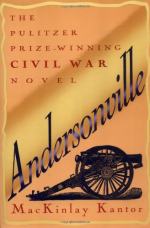8. On February 12, 1864, General Butler addressed a letter to the Rebel Commissioner Ould, in which be asked, for the sake of humanity, that the questions interrupting the exchange be left temporarily in abeyance while an informal exchange was put in operation. He would send five hundred prisoners to City Point; let them be met by a similar number of Union prisoners. This could go on from day to day until all in each other’s hands should be transferred to their respective flags.
The five hundred sent with the General’s letter were received, and five hundred Union prisoners returned for them. Another five hundred, sent the next day, were refused, and so this reasonable and humane proposition ended in nothing.
This was the condition of affairs in February, 1864, when the Rebel authorities concluded to send us to Andersonville. If the reader will fix these facts in his minds I will explain other phases as they develop.
CHAPTER XI.
Putting in the time—rations—cooking utensils—“Fiat” Soup—“Spooning” —African newspaper VENDERS—trading greenbacks for Confederate money —visit from John Morgan.
The Winter days passed on, one by one, after the manner described in a former chapter,—the mornings in ill-nature hunger; the afternoons and evenings in tolerable comfort. The rations kept growing lighter and lighter; the quantity of bread remained the same, but the meat diminished, and occasional days would pass without any being issued. Then we receive a pint or less of soup made from the beans or peas before mentioned, but this, too, suffered continued change, in the gradually increasing proportion of James River water, and decreasing of that of the beans.
The water of the James River is doubtless excellent: it looks well—at a distance—and is said to serve the purposes of ablution and navigation admirably. There seems to be a limit however, to the extent of its advantageous combination with the bean (or pea) for nutritive purposes. This, though, was or view of the case, merely, and not shared in to any appreciably extent by the gentlemen who were managing our boarding house. We seemed to view the matter through allopathic spectacles, they through homoeopathic lenses. We thought that the atomic weight of peas (or beans) and the James River fluid were about equal, which would indicate that the proper combining proportions would be, say a bucket of beans (or peas) to a bucket of water. They held that the nutritive potency was increased by the dilution, and the best results were obtainable when the symptoms of hunger were combated by the trituration of a bucketful of the peas-beans with a barrel of ‘aqua jamesiana.’




